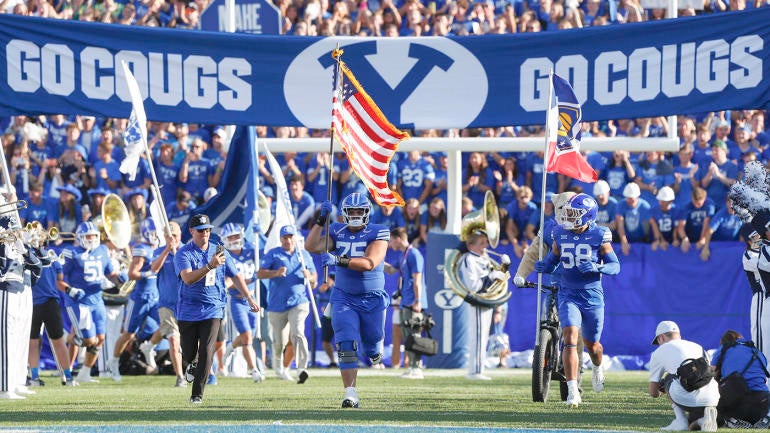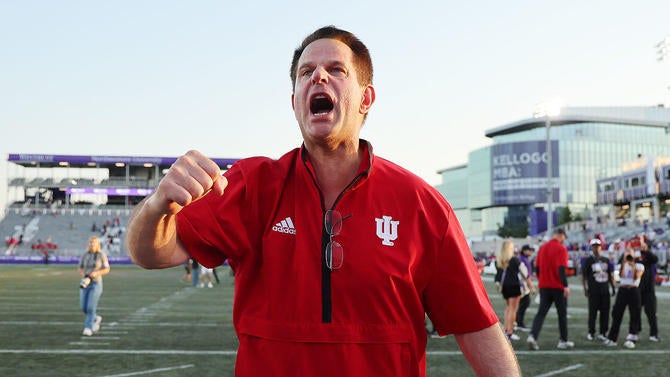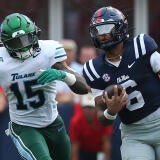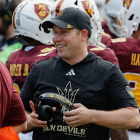College football storylines to watch over second half of 2024 season as unlikely stars drive CFP, Heisman talk
These seven storylines will dominate conversation of college football for the second half of 2024

Before the kickoff of the first game of the 2024 season, we always knew this would be a turning point in the 150-plus year history of college football. The combination of massive conference realignment and the expansion of the College Football Playoff shifted the landscape in ways that figured to make the sport unrecognizable.
Yet, here we sit at the midpoint of the season and college football feels surprisingly, and pleasantly, comfortable.
Sure, there are big-picture issues: NCAA governance; the prospects of employment for athletes through the House settlement; conferences and schools are suing each other; and a general consternation over what the sport might look like in 5-10 years.
But step back from the dizzying ledge of what is unknown and focus on what is in front of our faces, because the heart of college football is beating strong in 2024 and we've got a great season on our hands.
The players and coaches sacrificing their time and energy for each other and their schools in this very moment are not concerned with media rights deals or automatic bids. The Vanderbilt students who marched goalposts down Broadway in downtown Nashville after beating Alabama haven't double-checked to see what the TV rating market share was for one of the biggest wins in school history. And across the country there are former students who, for the first time in 2024, took their children to a game to begin passing on the passion of college football to the next generation. And it is highly unlikely anyone in that family considered the latest 16-slide power presentation on the latest super league proposal from their seats in Section 212.
A half-decade ago, a power-conference commissioner stopped me in a line of questioning in the midst of a conversation about conference realignment. Take a step back and look at the entire history of the sport, he suggested, and you'll be reminded that these changes have always happened. As fans, we are stunned and confused in the moment, but give us a couple of weeks and we'll transition into comfort, and even appreciation, with the new set of circumstances. Because ultimately, the heart of college football is in a college football Saturday. And as long we've got the players, coaches and stadiums full of fans for those sacred days in the fall, the sport will feel comfortable.
College football is the most human sport in America. It is imperfect and constantly changing, but it thrives thanks to the connection between people. You can change the College Football Playoff invitational or shake up the conferences, but after a half-dozen Saturdays, any season can feel as comfortable as the one we're in right now.
Let's dig into seven storylines to watch for the second half of the 2024 season.
Old guard dealing with early season adversity
Alabama, Georgia, Clemson and Ohio State combined to win eight of the 10 championships in the four-team era of the College Football Playoff. They also combined for 22 appearances, and some combination of those four programs squared off 12 times in the CFP, with six of those meetings coming in the title game. Those four programs stand out as the powers of the four-team era, but in 2024, all four have suffered a loss before mid-October.
Because we are in the 12-team era, and all of those teams are currently in the top 10 of the AP poll, taking an early loss has not eliminated these title-winning programs from remaining in the hunt to win it all. But it has created a fascinating dynamic to see these programs already dealing with adversity and one step off the pace from some fresh faces looking to make a splash in this new format.
Texas and Oregon have just one CFP appearance each, with the Ducks reaching the title game in the first edition in 2014-15, and the Longhorns breaking through just last season. Penn State has no playoff appearances to its name but has been one of the most consistent programs of the last era and largely viewed as a team most likely to benefit from an expanded field. All three of those teams are undefeated and a step ahead of the old guard, with the Ducks already scoring one against Ohio State and Texas staring down an opportunity to do the same against Georgia in Week 8.
It's far too early to declare this a "passing of the torch," because water very well might find its level (and possibly as soon as Saturday), but the divide in playoff pedigree is notable when considering the top teams in the sport at the midseason point.
Surprise teams contending in power conferences
There are six power-conference teams who were not ranked in the preseason, yet find themselves in the AP poll heading into Week 8. All sit within one game of first place in the loss column in their respective conference standings. The path forward for Iowa State, Indiana, Illinois, BYU, Pitt and SMU is different for each team, but each case is a unique success story worth celebrating now and tracking in the weeks ahead.
Iowa State's success is a product of the winning culture ninth-year coach Matt Campbell has established in Ames, but there is a more instant impact with Curt Cignetti at Indiana. Cignetti has not only positioned the Hoosiers for a historic season but appears to have delivered an injection of confidence to a program that has spent much of its history looking up in the Big Ten standings. The Hoosiers are undefeated with games against Ohio State and Michigan in the coming weeks to determine their Big Ten title contention status, but even being at this point in mid-October is something not many sportsbooks saw coming in July. The same could be said for Pitt or BYU, who were picked in the bottom half of their respective conferences but have started undefeated and face realistic paths to competing for a conference title, and thus a CFP spot.

Illinois and SMU have already taken one loss each, but the Fighting Illini have the opportunity to open up their chances at making a run with games against Michigan (on CBS this Saturday) and Oregon in the coming weeks. SMU has already faced some of its stiffest conference competition, but it has a crucial showdown with the aforementioned Pitt Panthers looming on Nov. 2.
Most anticipated Commander-In-Chief's Trophy battle in the modern era
For the first time since 1960, Army and Navy are ranked in the AP poll at the same time. Given the level of performance during undefeated starts for both teams and the schedule ahead, it's possible we see the most anticipated Army-Navy game in years at the end of the season. What's making that rivalry even more interesting is how the AAC Championship Game and College Football Playoff might factor into America's Game.
Army and Navy are engaged in a 12-month rivalry that includes the Commander-In-Chief's Trophy, a competition they share with Air Force. For the first time, however, they are in the mix for the AAC title as well. Navy has been an AAC member since 2015, but now Army has joined the Midshipmen in shedding their independent status to join a conference race. Army is out in front with a 5-0 record in conference play already, but Navy has the opportunities to match that in the coming weeks thanks to a 3-0 start against league competition. It's possible, then, that Army and Navy are not only in competition with each other for military academy supremacy, but also the honor of being one of the five highest-ranked conference champions at the end of the season.
We haven't seen Army and Navy square off as ranked teams since 1957, but if we get that in the AAC title game, then it quite possibly could be for a spot in the College Football Playoff.
The bubble and the seeding battle
Speaking of, the second half of the season will include a heavy dose of CFP talk, and much of that will come from the position of experts who don't know what they're talking about -- but seriously, we've never gone through a 12-team playoff race and therefore no one knows exactly how this is going to go for Year 1. We will get some hints thanks to weekly selection committee rankings that will begin Nov. 5, but this will largely be a trial by fire for all of college football as we get used to the rhythms of a new postseason format.
There are three big conversations that seem important when it comes to the 12-team CFP and how we talk about it on a weekly basis in November. First, the conference title races are the most important and practical angle to analyze. Those competitions which are based on records and tiebreakers will determine the four teams who get a first-round bye and the fifth team who might get to jump the line in terms of the overall rankings. It's a huge advantage for teams who might not be in the top four overall (or even the top 12) to have a path to a favorable spot in the playoff, and it's a process that largely makes sense.
What will make much less sense are the next two conversations: seeding among likely at-large teams and the bubble. CFP projections are unveiled every week with a bracket similar to the bracketology that dominates the run-up to March Madness in college basketball. But when home field advantage and playoff path are at stake, the passion and importance behind these seemingly small decisions are going to be scrutinized extensively. The same can be said for the playoff bubble, which will include the same kind of "Last 4 In/First 4 Out" drama that drives a ton of interest in college basketball. The only issue here is, unlike hoops, college football teams don't get a full conference tournament opportunity to string together multiple games to impress the committee. There will be bubble talk, but how much power teams have over their future is much more limited due to the constraints of the late-season schedule.
Hot seat outlook
There are many years when we reach the midseason point with multiple power-conference jobs already open, but despite some obvious hot seat options on betting sites, so far we don't have any movement on the coaching carousel. So as the season winds down, there will be more buzz and attention from fans on whether a move will be made -- and, if so, the timing to get a coaching search started.
Timing does feel like an important piece of this, because it has been suggested that the expanded CFP will impact the coaching carousel in ways that could delay some changes. After all, if you are a power-conference program looking to make a hire, it's possible -- if not likely -- that at least one of your candidates are somehow involved in the 12-team CFP. We have seen coaches leave their team before a major bowl game before, or even announce their intentions to depart after the game, but never in a situation where that team is as explicitly in the mix for a national championship as a playoff team would be in 2024.
In terms of attention, the focus certainly begins with Billy Napier at Florida and Sam Pittman at Arkansas. Pittman has cooled the hot seat talk with a home win against Tennessee and has the chance to replicate that positive momentum with a game against LSU on Saturday night. Napier has not had the same big wins, but the Gators have also not totally cratered despite obvious limitations.
Jeanty, Hunter headline norm-breaking Heisman race
Of all the Heisman Trophy winners since 2000, only four have not been quarterbacks. And in the case of all four -- Reggie Bush in 2005, Mark Ingram in 2009, Derrick Henry in 2015, DeVonta Smith in 2020 -- it has been a star player for a blue-blood program competing for a national championship at the time of the Heisman voting. So it's a remarkable development that, as we sit here at the midseason point, the two stars at the center of the Heisman Trophy conversation (odds per BetMGM) are both A) not quarterbacks and B) not playing for blue-blood national title-competing programs.
In fairness to Boise State and Colorado, there are paths to reaching the College Football Playoff and thus competing for a national title, but no one is confusing the way those two programs resonate nationally with Alabama or USC. Boise State RB Ashton Jeanty is chasing history, specifically Barry Sanders' 36-year old single-season rushing record. With a 208 yards per game average heading into Week 8, Jeanty is on pace to come extremely close to Sanders' record by the end of the year. If he does, there's a fantastic case for preserving this immortal season by naming him the Most Outstanding Player in college football.

But there's also an equally captivating case for Travis Hunter, who has already broken the norms for what we expect from even our most outstanding two-way players. Hunter was a CBS Sports Midseason All-American as both a cornerback and all-purpose player, but he's also one of the top 10 wide receivers in the country heading into Week 8.
Charles Woodson, the first and currently only defensive Heisman Trophy winner, contributed at wide receiver for Michigan and had some big catches in big games, but his work load does not match the production we have seen from Hunter.
There are a set of norms we have come to expect from our Heisman Trophy contenders, but with two non-quarterbacks playing for non-blue bloods, we are dangerously close to shattering those norms if Jeanty and Hunter can replicate their first-half performances over the final weeks of the season.
The haunting impact of the transfer portal
We have already seen players shutting it down for the year to preserve their eligibility with plans to transfer out of the program. We will continue to see these developments, some of them explicit in nature while others might be more implicit with extensive absences from game action. There is the notion, true or untrue, that teams are "sniffing around" or beginning to target players that they think could be ripe to jump into the transfer portal based on their current situation. There is back-room information trading with agents and personnel departments. It can be a little unsettling, but it is the reality of modern college football.
How fans differ on their opinions of this side of the business isn't really relevant to whether or not it has an impact, because it does and will continue to in the current environment. As 2024 expectations continue to fall out of reach each week for teams across the country, a small number of valuable players are going to face moments when their commitment to their current situation will be tested. Many follow through on the commitments they made at the start of the season to their teams, but others will choose to preserve health and/or eligibility with eyes elsewhere. Both player interests and the responsibility for opposing teams to be active in the roster building process has made the sport unrecognizable for some. But, if you can keep up, you'll realize the portal era's impact extends far beyond the portal windows.


















